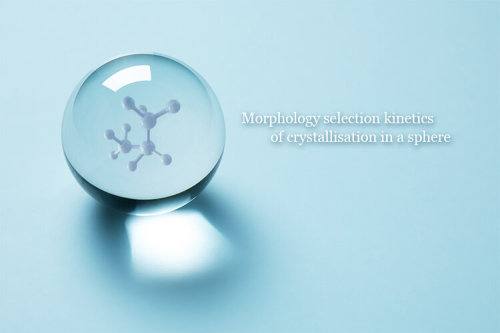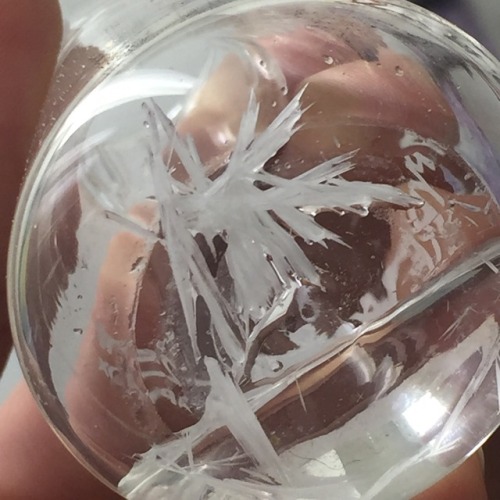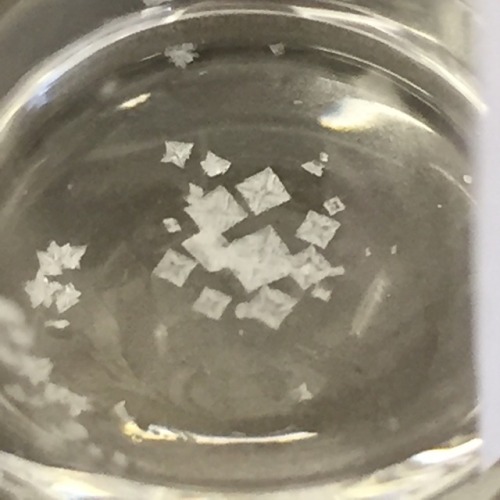#crystallization
Midair crystallization.
It’s not magic, it’s acoustic levitation. The two metal probes emit and reflect sound waves that trap this liquid droplet in midair. Franziska Emmerling uses the effect to study crystallization without interference from container walls, which can influence the rate of crystal formation (Cryst. Growth Des. 2014, DOI: 10.1021/cg501287v). “In a typical experiment, we use an under saturated solution of a certain compound,” she says. “During the experiment, solvent evaporates from the droplet and the saturation level increases leading to nucleation and then crystallization.” In this photo, however, they’re just levitating blue ink to demonstrate the apparatus.
Emmerling (@FranEmmerling) submitted this photo as part of the #RealTimeChem photo contest on Twitter. The two runners-up in the Reactions category were Henry Powell-Davies (@hpowelldavies) with his balloon reaction and the Townsend lab at Vanderbilt (@Townsend_Lab) with a well-composed flask shot.
Credit: Courtesy of Franziska Emmerling
Do science. Take pictures. Win Money. Enter our photo contest here.
Related C&EN Content:
Lab Levitation, How Bubbly Is Bubbly?
Post link
Think about your favorite toys as a child. Did they light up or make funny noises when you touched them? Maybe they changed shape or texture. In the last week’s edition of ACS Central Science, researchers report a new material that combines many of these characteristics. Beyond being fun, t…
Crystallization
Crystallization (natural or artificial) is the process of formation of solid crystals precipitating from a solution, melt or more rarely deposited directly from a gas. Crystallization is also a chemical solid–liquid separation technique, in which mass transfer of a solute from the liquid solution to a pure solid crystalline phase occurs. Crystallization is therefore an aspect of precipitation, obtained through a variation of the solubility conditions of the solute in the solvent, as compared to precipitation due to chemical reaction.
~Giffed by: rudescience From:This video
Post link
Scientists discover new field affecting metals solidification
A fundamental discovery that alters our current understanding of how metals solidify and form crystalline patterns may help lead to better control of casting and welding processes. It also explains how snowflakes and many mineral patterns form naturally.
Reexamining data from his 20-year-old NASA experiment involving the repeated freezing and melting of high-purity materials in microgravity, Martin Glicksman, research professor in materials science and the Allen Henry Chair at Florida Institute of Technology, working with Kumar Ankit at the School of Matter, Transport and Energy at Arizona State University, discovered the way nature guides formation of complex patterns in materials that crystallize.
Glicksman discovered an energy field affecting all crystallizing substances, which he labeled the bias field that he believes is nature’s way of guiding cellular and branching dendritic microstructures that form during solidification of most metals and alloys.
“In the last phases of melting, needle-like crystals suddenly changed to spheres, and so for the first time ever, as we watched stationary particles melting in microgravity and observed their rather remarkable shape change,” Glicksman said.
Post link
Faster way to make mineral to remove carbon dioxide from atmosphere
Scientists have found a rapid way of producing magnesite, a mineral which stores carbon dioxide. If this can be developed to an industrial scale, it opens the door to removing CO2 from the atmosphere for long-term storage, thus countering the global warming effect of atmospheric CO2. This work is presented at the Goldschmidt conference in Boston.
Scientists are already working to slow global warming by removing carbon dioxide from the atmosphere, but there are serious practical and economic limits on developing the technology. Now, for the first time, researchers have explained how magnesite forms at low temperature, and offered a route to dramatically accelerating its crystallization. A tonne of naturally-occurring magnesite can remove around half a tonne of CO2 from the atmosphere, but the rate of formation is very slow.
Project leader, Professor Ian Power (Trent University, Ontario, Canada) said: “Our work shows two things. Firstly, we have explained how and how fast magnesite forms naturally. This is a process which takes hundreds to thousands of years in nature at Earth’s surface. The second thing we have done is to demonstrate a pathway which speeds this process up dramatically.”
Post link
Having a ball: Crystallization in a sphere
Crystallization is the assembly of atoms or molecules into highly ordered solid crystals, which occurs in natural, biological, and artificial systems. However, crystallization in confined spaces, such as the formation of the protein shell of a virus, is poorly understood. Researchers are trying to control the structure of the final crystal formed in a confined space to obtain crystals with desired properties, which requires thorough knowledge of the crystallization process.
A research group at the Institute of Industrial Science, the University of Tokyo and Fudan University, led by Hajime Tanaka and Peng Tan, used a droplet of a colloid—a dispersion of liquid particles in another liquid, like milk—as a model for single atoms or molecules in a sphere. Unlike single atoms or molecules, which are too small to easily observe, the colloid particles were large enough to visualize using a microscope. This allowed the researchers to track the ordering of single particles in real time during crystallization.
“We visualized the organization process of colloid particles in numerous droplets under different conditions to provide a picture of the crystallization process in a sphere,” says Tan.
Post link
“…the western consciousness tries to read the jungle, seeks to find the fulfillment of its desires in its encounter with a vivid and prolific landscape, a hint of the experience of appreciation of the ‘sublime’, but then a counter movement which ‘retreats’ from enacting in poetry a moment of unification of nature, landscape, colonizer, tourist and native other, a pulling back to recognize alienation and difference – not blanket harmony.” – Helen M. Dennis, “Bishop and the Negative Sublime”
(Crystal, Tel Aviv, 2008)
Post link
Bonus crystals of my new complex! I hope to get a time lapse of their growth one day because it’s so stunning to watch
Off to the diffractometer!
Post link











